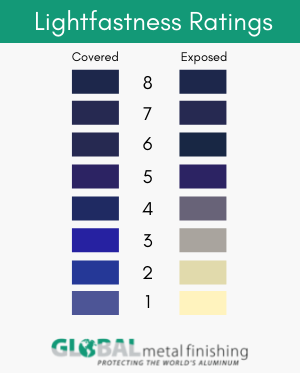Lightfastness of Dyes: Understanding Color Fading in Anodized Aluminum Parts
When new customers come to us for metal finishing services, one of their biggest concerns is color fading.
Anodized aluminum parts can fade once exposed to sunlight, but in many cases, the fading can be minimized—with the right color selections and the right metal finishing partner.
Today, we’ll explore a critical concept known as lightfastness and review other color-fading factors that are important to consider for anodized aluminum.
What Is Lightfastness, and Why Is It Important?
Lightfastness is a property describing how resistant a given dye is to fading when exposed to UV light.
It’s common knowledge that UV light has the power to fade colors. In anodized aluminum parts, the photons in UV light react with dye molecules, making them unstable and causing the color to fade. Dyes that are more stable when exposed to UV light are also more resistant to fading, thus making them more lightfast.

In the metal finishing industry, we use the Blue Wool Scale to measure the lightfastness of dyes. Initially developed for the textile industry, this scale has since been adopted by many other industries in which color is of central importance. The Blue Wool Scale ranges from 1-8, with 8 representing excellent lightfastness (the most resistant to fading) and 1 representing poor lightfastness (the least resistant to fading).
If you plan to have a part color anodized, it’s important to consider its exposure to UV light in the end-use application. To minimize the fading of your part’s color in these applications, you’ll need a dye that rates highly on the Blue Wool Scale; otherwise, your parts will fade quickly when exposed to sunlight.
Other Factors to Consider Regarding Color Fading
Lightfastness isn’t the only factor that plays a role in how much or how quickly color fades on anodized aluminum. Here’s what else you should know about color fading:
1. Darker vs. lighter colors
There’s a common misconception that darker colors fade more over time than lighter colors, but this isn’t necessarily the case. Fading depends on the stability of the molecules in a given dye, not the color of the dye itself.
2. Color inconstancy
Sometimes, after a part has been anodized, the metal finisher confirms a color match during inspection, but when the customer receives the part, the color appears to be a slightly different shade.
This apparent mismatch results from what we call color inconstancy, a phenomenon that describes a color changing in appearance when viewed under different light sources. The lighting at the finishing shop is different from the lighting at the customer’s location, causing the perception of two different colors.
3. UV protective coatings
Customers naturally think that an easy way to avoid color fading is to have their metal finisher add a UV protective coating to their parts. But UV protective coatings usually aren’t an optimal solution because they eventually chip or rub off of the anodic coating, leaving a less than desirable texture and cosmetic appearance.
At Global Metal Finishing, we can work with you to minimize color fading in your anodized aluminum parts. If your part will be exposed to UV light and you’re concerned about fading, we recommend let us know during our initial conversations so we can make the best color-related recommendations. Contact us today for a free quote!
